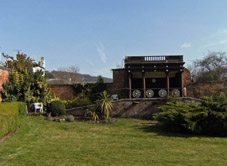Nelson Garden facts for kids
Quick facts for kids The Nelson Garden |
|
|---|---|

Nelson's Seat
|
|
| Type | Garden |
| Location | Chippenhamgate Street |
| Nearest city | Monmouth |
| Created | 19th century |
| Status | Grade II* listed (structures) |
The Nelson Garden is a special garden in Monmouth, Monmouthshire, Wales. It's famous because a very important person, Lord Nelson, visited it in 1802. He even had a tea party there! This garden is one of 24 interesting places you can visit on the Monmouth Heritage Trail. You enter the garden through a short tunnel that goes under an old medieval town wall. A group called a trust now looks after the garden.
A Garden Through Time
This garden has a long history! In the 1600s, it was a place for a game called real tennis, which is an older version of tennis. By 1718, it had become a bowling green, a smooth lawn for playing bowls. Later, it was an orchard, a place where fruit trees grew. You can still see parts of an old heated wall from the 1700s. This wall, called a hypocaust wall, was warmed to help fruit trees grow flat against it, a method called 'espaliered'. Deep under the lawn, there are even older remains from Roman and Norman times.
Lord Nelson's Special Visit
The Nelson Garden is named after Lord Nelson because he visited Monmouth on August 19, 1802. He was with Sir William and Lady Emma Hamilton during their trip to the Wye Valley. After having a meal at the Beaufort Arms, they went to a "beautiful summerhouse" in this garden. There, they enjoyed tea and spent the evening in this lovely spot.
The original summerhouse is no longer there. But around 1840, a new building called the Memorial Pavilion was built. It might have been designed by George Vaughan Maddox, a local architect. Because it's made of wood, parts of it have been replaced over the years. No one knows how much of it is truly original. Inside, you can find "Lord Nelson's Seat," which has a plaque remembering Nelson's visit. This summerhouse is considered "important and unusual" by experts.
Saving the Garden
For many years, until 1950, the people who managed the nearby Lloyds Bank helped take care of the garden. After that, the garden started to get run down. But in 1994, two groups, the Nelson Society and the Monmouth Archaeological Society, began to restore it.
In 1996, the Welsh Historic Gardens Trust joined in. They set up a special committee in 1997 to look after the garden. In 2001, this committee made an agreement with Lloyds Bank to use the garden for 10 years. They also paid for repairs to the entrance tunnel and added a nice iron screen to separate the garden from the bank's property. Today, the garden is usually open to the public from April to September, on Fridays between 2 and 4 p.m.
The buildings in the garden, including the Pavilion, are listed as Grade II* listed. This means they are very important historic structures. The garden itself is listed as Grade II. The Nelson Garden Preservation Trust now manages the garden. Their goal is to fully restore it, with advice from Cadw, and to open it regularly for everyone in Monmouth to enjoy. They also work to make sure the garden will be cared for in the future.
Gallery





